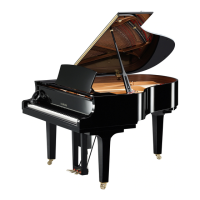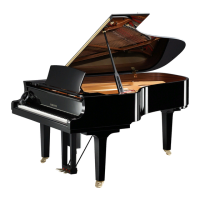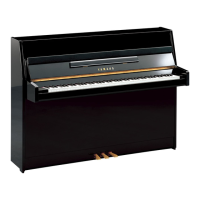Why Yamaha Disklavier E3 shows CANNOT EXECUTE TO DELETE 1ST ALBUM?
- SShane RodriguezSep 22, 2025
If your Yamaha Musical Instrument displays 'CANNOT EXECUTE TO DELETE 1ST ALBUM', you cannot delete the first album in a medium.
Why Yamaha Disklavier E3 shows CANNOT EXECUTE TO DELETE 1ST ALBUM?
If your Yamaha Musical Instrument displays 'CANNOT EXECUTE TO DELETE 1ST ALBUM', you cannot delete the first album in a medium.
What to do if KD/PD Connection error appears on Yamaha Disklavier E3?
If you encounter a 'KD/PD Connection error' with your Yamaha Musical Instrument, the cable on the key drive unit or pedal drive unit might be faulty. Check the cable used to connect these units.
How to troubleshoot KS line disconnected error on Yamaha Disklavier E3?
If you see 'KS line disconnected' on your Yamaha Musical Instrument, it means communication is lost between the key sensor unit and the CSP unit. You should check the cable connecting these units.
What does KD ASIC error mean on Yamaha Disklavier E3 Musical Instrument and how to fix it?
If you are getting a 'KD ASIC error' on your Yamaha Musical Instrument, it indicates a communication problem between the key drive unit and the CSP unit. Check the cable that connects these two units.
What does CANNOT EXECUTE PROTECTED FILE mean on Yamaha Disklavier E3 Musical Instrument?
If your Yamaha Musical Instrument shows 'CANNOT EXECUTE PROTECTED FILE', you cannot copy the protected song file to the removable medium.
What to do if Yamaha Disklavier E3 shows PLAYLIST NOT FOUND?
If your Yamaha Musical Instrument is showing 'PLAYLIST NOT FOUND', you must first create a new playlist and then add songs to it.
How to fix Calibration : E1 error on Yamaha Disklavier E3 Musical Instrument?
If you are getting 'Calibration : E1' error on your Yamaha Musical Instrument, do the pedal adjustment and half point adjustment.
How to solve Soft Stroke : E1 error on Yamaha Musical Instrument?
If you are getting 'Soft Stroke : E1' error on your Yamaha Musical Instrument, do the pedal adjustment and re-measure.
What does E0 error mean on Yamaha Disklavier E3 Musical Instrument and how to fix it?
If your Yamaha Musical Instrument displays 'E0', check the key adjustment, paying particular attention to uneven keys in the balance section. Also, verify the key rail adjustment, key sensor’s height adjustment, sensor head position, and key shutter. Finally, carry out the measurement again.
What does E1:KS REST AD is too low mean on Yamaha Disklavier E3 and how can I fix it?
If your Yamaha Musical Instrument displays 'E1:KS REST AD is too low', check the key sensor’s height adjustment, sensor head position, and key shutter. Carry out the measurement again.
Important cautions for adjusting piano components.
Steps for adjusting loud pedal gap and damper felt lift.
Steps for adjusting soft pedal cylinder and striking distance.
Steps for pedal calibration via service center mode.
Details factory settings and clearance adjustment for key sensors.
Procedure for testing and adjusting hammer sensors.
Explains clearance adjustments for the key drive unit.
Notes that pedal drive position requires prior calibration.
Details adjustments for shank stopper height and lateral position.
Steps to check shank stopper movement in quiet mode.
Details how to adjust the hammer sensor height.
Explains clearance adjustments for the key sensor unit.
Details clearance adjustment for the key drive unit.
Procedure to access the service center mode.
Accesses system, version, and unit information.
Lists various test play scenarios for scales and pedals.
Accesses standard, pedal, and full calibration routines.
Covers series calibration for sensors, pedals, and key drive.
Adjusts the half point timing for pedal operation.
Executes comprehensive calibration for series, sensors, pedals, and key drive.
Lists errors related to recording, albums, and playlists.
Prompts for connecting USB HDD for backup.
Errors from excessive key drive or pedal solenoid temperature.
Errors due to lost communication or faulty cables.
Error related to damaged measurement table or CSP sheet.
Errors in key sensor rest/end values and pedal stroke.
Errors from incompatible sensor values or inability to obtain events.
Troubleshooting steps for power-related issues.
Troubleshooting steps for lack of playback.
Addresses issues like no recording, missing notes, and volume differences.
Important cautions for adjusting piano components.
Steps for adjusting loud pedal gap and damper felt lift.
Steps for adjusting soft pedal cylinder and striking distance.
Steps for pedal calibration via service center mode.
Details factory settings and clearance adjustment for key sensors.
Procedure for testing and adjusting hammer sensors.
Explains clearance adjustments for the key drive unit.
Notes that pedal drive position requires prior calibration.
Details adjustments for shank stopper height and lateral position.
Steps to check shank stopper movement in quiet mode.
Details how to adjust the hammer sensor height.
Explains clearance adjustments for the key sensor unit.
Details clearance adjustment for the key drive unit.
Procedure to access the service center mode.
Accesses system, version, and unit information.
Lists various test play scenarios for scales and pedals.
Accesses standard, pedal, and full calibration routines.
Covers series calibration for sensors, pedals, and key drive.
Adjusts the half point timing for pedal operation.
Executes comprehensive calibration for series, sensors, pedals, and key drive.
Lists errors related to recording, albums, and playlists.
Prompts for connecting USB HDD for backup.
Errors from excessive key drive or pedal solenoid temperature.
Errors due to lost communication or faulty cables.
Error related to damaged measurement table or CSP sheet.
Errors in key sensor rest/end values and pedal stroke.
Errors from incompatible sensor values or inability to obtain events.
Troubleshooting steps for power-related issues.
Troubleshooting steps for lack of playback.
Addresses issues like no recording, missing notes, and volume differences.
| Brand | Yamaha |
|---|---|
| Model | Disklavier E3 Series |
| Category | Musical Instrument |
| Language | English |











